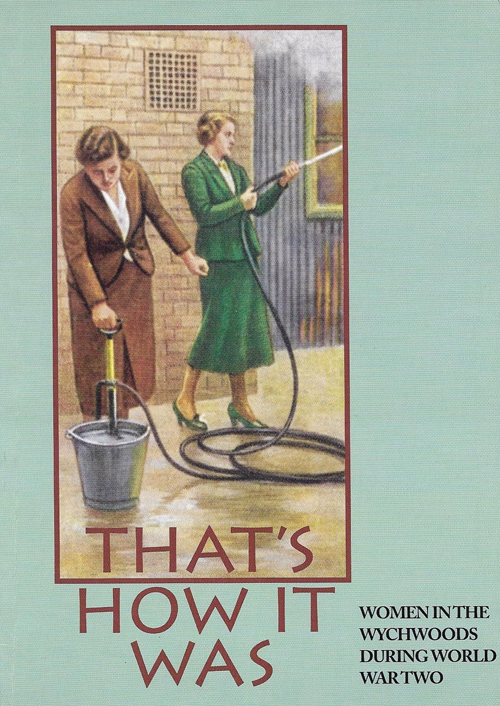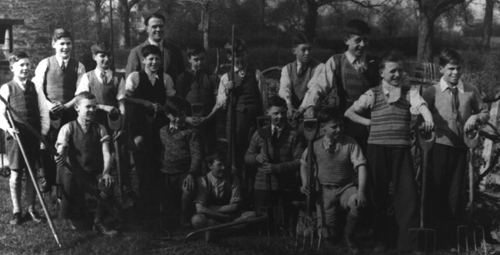“That’s How it Was” | Introduction | Wychwood Women : The Interviewees | Declaration of War | The Arrival of Evacuees| School Time | Preparing for War at Home | Soldiers and Airmen | For the Common Cause | Dr Scott and the Canteen | Domestic Life | We Were Lucky Out Here: Food Rationing | Work for Women Outside the Home | The Effects of War

… from the Wychwoods “That’s How It Was” Publication
During the war years Milton Council Primary school had the good fortune to have the same three teachers, who all lived in Milton, for the whole period, although there were constant changes of the evacuated staff. Shipton Church of England School was less fortunate and had many staff changes with different head teachers.
In 1939 Shipton CE school was the only school in the Wychwoods to take children for the full elementary age range of five to 14 years. Children from Ascott transferred to Shipton at 11. Milton school children were bussed to Burford at 11 or, if the parents preferred a Church of England education, they transferred to Shipton. Access to Burford Grammar school was by payment of fees or by gaining a County scholarship.
Following the arrival of the first evacuees most schools were overcrowded, and all had primitive conditions – no running hot water, primitive toilets, no blackout and little in the way of air raid precautions like shelters. Milton and Shipton schools had heating problems with their high vaulted roofs. There were coal shortages and there was difficulty in obtaining cleaners to light fires. Throughout the war years there were spells of icy weather when water froze in the taps and periods of thaw when the drains were blocked. Even when they were open they were still cold; in January 1941, Shipton school log book recorded ‘School very cold, although good fires are burning. Temperature at 10am only 38 degrees F’.
To the question ‘was it cold in school?” Valerie Davis said ‘It must have been, but there again, was it imagination?‘ Peter Davis added ‘You dressed accordingly or hopefully you did anyway. There was the big tortoise stove in the big room with a guard round it.’
To cope with the evacuees, Shipton school obtained the use of the YMCA Red Triangle hut and the Beaconsfield Hall. But by October 1939 both had to be given up, the former as it was ‘unsuitable, poor light and ventilation’ and the hall was requisitioned by the military who also commandeered the cookery hut in the playground for use as a NAAFI canteen.
In Milton the Baptist schoolroom and the British Legion Hall were obtained for use. The Milton and London children used these places alternately, desk work being taken at the school and oral work in the halls; the same regime was used at Shipton. Later that year use of the Legion hall was discontinued. Milton children and evacuated boys were taught at the school and evacuated infants and girls were taught in the Baptist Hall.
The first evacuated children from Upton Cross who came to Shipton, were transferred after only four months to Launton village near Bicester. The reason given in the school logbook was ‘unsuitable and unsanitary conditions pertaining to the old buildings’.
Thereafter Shipton school received no official evacuees apart from those transferred from Ascott at 11, those who changed billets and 13 evacuees from East Ham in October 1940 who arrived in Shipton with their mothers. In Milton, 39 more children arrived from Dagenham in June 1940, with 20 more September, along with ten from Lyneham, some of whom were also evacuees.
At this time the Church Room was also brought into use as part of the school. Like most children, Valerie Davis, Mary Barnes, Barbara Pearce and her husband, Colin (included here because his mother was Headmistress at Milton Primary School) seemed to have just accepted the situation and remember good relations with the newcomers after initial settling down.
‘I even remember when the class sizes went up considerably when the evacuees came, obviously. I think they were thought to be rather odd to start with but I mean I made some very good friends with evacuees’. Colin Pearce
‘The evacuees were integrated with us. I can remember at Milton there were so many of us there, and with the evacuees’ teachers going over to the church room. I mean there was the curtain down the middle of the big room. But you just got on with it’. Valerie Davis
‘We just learned from the books that were provided and didn’t feel there was any shortage, Mrs Pearce’s word was the rule and that was it. Barbara Pearce
I don’t remember shortages of anything probably because my mum was headmistress and she was a pretty stern woman. She loved her job and she fought tooth and nail to get things for the school’. Colin Pearce

There was little enthusiasm for school meals when they could be remembered at all.
‘I can remember school dinners. Mrs Hawcutt and Mrs Harry Smith used to do it, and it was always the same, except at some time there must have been some food parcels came to school and we had some chocolate rice and the headmistress said how wonderful it was and how grateful we should be, but it was really not very nice, but you were made to feel you’d got to eat it whether you… because it was good for you, but that was the whole policy, it was good for you’. Valerie Davis
‘We didn’t have school meals, I don’t think, not at St Mary’s [Shipton]. I used to go home for dinner because we lived at Pike House then and so I always went home for lunch. Although there was a kitchen but I think that was later. I don’t know whether there was one when I was there, I can’t remember if they did school dinners. I expect I was awkward and went home’. Barbara Pearce
‘We used to go to cookery, I can’t remember where. Must have walked to Shipton; they had a hut along the side there. We used to knit socks and that sort of thing at school. I was there till I was 15 so we weren’t like little children, we were like secondary school children but we didn’t have exams or anything like that. They were very kind’. Mary Barnes
They were all older teachers, looking back, they were when we went to Grammar School. There were no young men about and that was it. They got it into your brain and that was it. Valerie Davis
“That’s How It Was” Menu
These pages are reproduced from the Society’s publication “That’s How It Was”, featuring women in the Wychwoods during World War Two. The texts and images were published in the year 2000, and deserve a place in our expanding online archive. Please bear in mind as you read our texts in these pages, that we reproduce them as published in the year of publication.
Select from:
“That’s How it Was” | Introduction | Wychwood Women : The Interviewees | Declaration of War | The Arrival of Evacuees| School Time | Preparing for War at Home | Soldiers and Airmen | For the Common Cause | Dr Scott and the Canteen | Domestic Life | We Were Lucky Out Here: Food Rationing | Work for Women Outside the Home | The Effects of War

